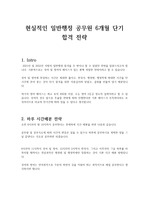소개글
"기능적 움직임 검사"에 대한 내용입니다.목차
1. 서론2. 기능적 움직임 검사(FMS)
1) 어깨 가동 패턴 검사
2) 능동적 다리 뻗기 검사
3) 몸통 회전 안정성 검사
4) 푸쉬업 검사
5) 인라인 런지 패턴 검사
6) 허들스텝 패턴 검사
7) 딥스쿼트 패턴 검사
3. 결론 및 뇌졸중 환자에게 적용
4. 참고문헌
본문내용
물리치료의 목적은 잘 움직이게 하는 것, 즉 움직이지 못하는 원인을 파악하여 해결함으로써 일상생활을 가능하게 하고 불편함을 최소로 만드키는 것이다. 물리치료는 ‘움직임’을 위한 것이 되어야 하고, 잘 움직일 수 있게 하는 것이다. 움직임은 인간의 삶에 중심이기 때문이다. 잘 움직인다는 것은 움직임의 질이 좋다는 것이다. 그렇다면 움직임의 질이 좋다는 것은 어떻게 알 수 있을까? 어떻게 평가하는 것이 좋은가? 운동능력을 평가하는 항목은 많다. 근력이나 순발력, 민첩성, 균형 능력뿐만 아니라 최대산소섭취량과 심박수 같은 요소가 있다. 하지만 이러한 것은 움직임에 대한 양적인 측정이다. 그동안 물리치료사나 스포츠 트레이너, 감독, 코치 등은 잘못된 자세를 파악하고 교정하는데 일반인 보다 탁월할 수 있지만, 움직임의 질을 파악하는 것은 주관적 경험과 직감적 능력에 의지하였고, 과학적이지 못하였다. 그래서 미국 물리치료사인 그레이 쿡(GRAY COOK)은 움직임의 질을 평가하는 체계적이고 정량화된 방법을 만들었다. 이것이 ‘기능적 움직임 검사와 평가’이다. 본문 내용은 그레이 쿡이 2012년에 완성한 ‘MOVEMENT, Funtional Movement System’을 기반으로 한다. 기능적 움직임 체계(Funtional Movement System)에는 기능적 움직임 검사(FMS, Funtional Movement Screen)와 선택적 기능적 움직임 평가(SFMA, Selective Funtional Movement Assessment)가 있다.참고 자료
Gray Cook(1921). MOVEMENT : Funtional Movement SystemAkuthota, V., & Nadler, S. F. (2004). Core strengthening. Arch Phys Med Rehabil, 85(3 Suppl 1), S86-92.
Anderson, K., & Behm, D. G. (2005a). The impact of instability resistance training on balance and stability. Sports Med, 35(1), 43-53.
Arendt-⌷Nielsen, L., Graven-Nielsen, T., Svarrer, H., & Svensson, P. (1996). The influence of low back pain on muscle activity and coordination during gait: a clinical and experimental study. Pain, 64(2), 231-240.
Bennell, K. L., Malcolm, S. A., Thomas, S. A., Reid, S. J., Brukner, P. D., Ebeling, P. R., et al. (1996). Risk factors for stress fractures in track and field athletes. A twelve-month prospective study. Am J Sports Med, 24(6), 810-818.
Brenner, A. K., Gill, N. W., Buscema, C. J., & Kiesel, K. (2007). Improved activation of lumbar multifidus following spinal manipulation: a case report applying rehabilitative ultrasound imaging. J Orthop Sports Phys Ther, 37(10), 613-619.
Browder, D. A., Childs, J. D., Cleland, J. A., & Fritz, J. M. (2007). Effectiveness of an extension oriented treatment approach in a subgroup of subjects with low back pain: a randomized clinical trial. Phys Ther, 87(12), 1608-1618; discussion 1577-1609.
Butler, R. J., Plisky, P. J., Southers, C., Scoma, C., & Kiesel, K. B. (2010). Biomechanical analysis of the different classifications of the Functional Movement Screen deep squat test. Sports Biomech, 9(4), 270-279.
Chaiwanichsiri, D., Lorprayoon, E., & Noomanoch, L. (2005). Star excursion balance training: effects on ankle functional stability after ankle sprain. J Med Assoc Thai, 88 Suppl 4, S90-⌷94.
Cholewicki, J., Crisco, J. J., 3rd, Oxland, T. R., Yamamoto, I., & Panjabi, M. M. (1996). Effects of posture and structure on three-dimensional coupled rotations in the lumbar spine. A biomechanical analysis. Spine (Phila Pa 1976), 21(21), 2421-2428.
Cibulka, M. T., Sinacore, D. R., Cromer, G. S., & Delitto, A. (1998). Unilateral hip rotation range of motion asymmetry in patients with sacroiliac joint regional pain. Spine, 23(9), 1009-1015.
Clark, S., Christiansen, A., Hellman, D. F., Hugunin, J. W., & Hurst, K. M. (1999). Effects of ipsilateral anterior thigh soft tissue stretching on passive unilateral straight-leg raise. J Orthop Sports Phys Ther, 29(1), 4-9; discussion 10-12.
Cook, E. (2010). Movement. Aptos California: On Target Publishing.
Dahle, L. K., Mueller, M., Delitto, A., & Diamond, J. E. (1991). Visual assessment of foot type and relationship of foot type to lower extremity injury. J Orthop Sport Phys Ther, 14(2), 70-74.
Ellison, J. B., Rose, S. J., & Sahrmann, S. A. (1990). Patterns of hip rotation range of motion: a comparison between healthy subjects and patients with low back pain. Phys Ther, 70(9), 537-541.
Falsone, S. A., Gross, M. T., Guskiewicz, K. M., & Schneider, R. A. (2002). One-arm hop test: reliability and effects of arm dominance. J Orthop Sports Phys Ther, 32(3), 98-103.
Flor, H. (2003). Cortical reorganisation and chronic pain: implications for rehabilitation. J Rehabil Med(41 Suppl), 66-72.
Gribble, P. A., Hertel, J., Denegar, C. R., & Buckley, W. E. (2004). The Effects of Fatigue and Chronic Ankle Instability on Dynamic Postural Control. J Athl Train, 39(4), 321-329.
Hodges, P. W. (2011). Pain and motor control: From the laboratory to rehabilitation. J Electromyogr Kinesiol, 21(2), 220-228.
Iverson, C. A., Sutlive, T. G., Crowell, M. S., Morrell, R. L., Perkins, M. W., Garber, M. B., et al. (2008). Lumbopelvic manipulation for the treatment of patients with patellofemoral pain syndrome: development of a clinical prediction rule. J Orthop Sports Phys Ther, 38(6), 297-309; discussion 309-212.
Kiesel, K., Burton, L., & Cook, E. (2004). Mobility Screening for the Core. Athletic Therapy Today, 9(5), 42- 45.
Knapik, J. J., Jones, B. H., Bauman, C. L., & Harris, J. M. (1992). Strength, flexibility and athletic injuries. Sports Med, 14(5), 277-288.
Lanning, C. L., Uhl, T. L., Ingram, C. L., Mattacola, C. G., English, T., & Newsom, S. (2006). Baseline values of trunk endurance and hip strength in collegiate athletes. J Athl Train, 41(4), 427-434.
Leetun, D. T., Ireland, M. L., Willson, J. D., Ballantyne, B. T., & Davis, I. M. (2004). Core stability measures as risk factors for lower extremity injury in athletes. Med Sci Sports Exerc, 36(6), 926-934. Lyman, S., Fleisig, G. S., Waterbor, J. W., Funkhouser, E. M., Pulley, L., Andrews, J. R., et al. (2001).
McGill, S. M., Grenier, S., Kavcic, N., & Cholewicki, J. (2003). Coordination of muscle activity to assure stability of the lumbar spine. J Electromyogr Kinesiol, 13(4), 353-359.
Nadler, S. F., Malanga, G. A., Bartoli, L. A., Feinberg, J. H., Prybicien, M., & Deprince, M. (2002). Hip muscle imbalance and low back pain in athletes: influence of core strengthening. Med Sci Sports Exerc, 34(1), 9-16.
Nibu, K., Cholewicki, J., Panjabi, M. M., Babat, L. B., Grauer, J. N., Kothe, R., et al. (1997). Dynamic elongation of the vertebral artery during an in vitro whiplash simulation. Eur Spine J, 6(4), 286-289.
Panjabi, M. M., Cholewicki, J., Nibu, K., Grauer, J. N., Babat, L. B., & Dvorak, J. (1998b). Mechanism of whiplash injury. Clin Biomech (Bristol, Avon), 13(4-5), 239-249.
Reeves, N. P., Everding, V. Q., Cholewicki, J., & Morrisette, D. C. (2006). The effects of trunk stiffness on postural control during unstable seated balance. Exp Brain Res, 174(4), 694-700.
Renkawitz, T., Boluki, D., & Grifka, J. (2006). The association of low back pain, neuromuscular imbalance, and trunk extension strength in athletes. Spine J, 6(6), 673-683.
Shum, G. L., Crosbie, J., & Lee, R. Y. (2005). Effect of low back pain on the kinematics and joint coordination of the lumbar spine and hip during sit-to-stand and stand-to-sit. Spine, 30(17), 1998-2004.
Trojian, T. H., & McKeag, D. B. (2006). Single leg balance test to identify risk of ankle sprains. Br J Sports Med, 40(7), 610-613; discussion 613.
Tsao, H., Galea, M. P., & Hodges, P. W. (2008). Reorganization of the motor cortex is associated with postural control deficits in recurrent low back pain. Brain, 131(Pt 8), 2161-2171.
Vicenzino, B., Paungmali, A., & Teys, P. (2007). Mulligan's mobilization-with-movement, positional faults and pain relief: current concepts from a critical review of literature. Man Ther, 12(2), 98-108.
Willson, J. D., Dougherty, C. P., Ireland, M. L., & Davis, I. M. (2005). Core stability and its relationship to lower extremity function and injury. J Am Acad Orthop Surg, 13(5), 316-325.
Zazulak, B. T., Hewett, T. E., Reeves, N. P., Goldberg, B., & Cholewicki, J. (2007a). Deficits in neuromuscular control of the trunk predict knee injury risk: a prospective biomechanical-epidemiologic study. Am J Sports Med, 35(7), 1123-1130.
Zemper, E. D. (2003). Two-year prospective study of relative risk of a second cerebral concussion. Am J Phys Med Rehabil, 82(9), 653-659.
압축파일 내 파일목록
2. 기능적 움직임 검사.hwp



























